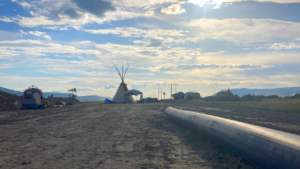Keystone Pipeline Leak Won’t Affect Expansion Decision
Nebraska regulators are not allowed to consider pipeline safety in deciding whether to expand the project.LINCOLN, Neb. — Discovery of a 210,000-gallon oil spill from the Keystone pipeline that critics say demonstrates the risks of energy transport to the environment will not affect Nebraska regulators’ decision next week on an expansion of the system because they are not allowed to consider pipeline safety, a state official said Friday.
Keystone operator TransCanada Corp. shut down the pipeline early Thursday morning and workers were testing to determine the cause of the spill on agricultural land in Marshall County, South Dakota, near the North Dakota border about 250 miles (402 kilometers) west of Minneapolis.
The spill announcement came just four days before the Nebraska Public Service Commission votes Monday whether to allow the Keystone XL expansion pipeline to cross the state. A state law passed in 2011 prevents the commission from factoring pipeline safety or the possibility of leaks into its decisions.
The vote Monday will be on a proposed route for the Keystone XL, which also would be operated by TransCanada. The new pipeline would carry an estimated 830,000 barrels of oil a day from the oil sands areas of Canada through Montana, South Dakota and Nebraska, where it would connect with the existing Keystone pipeline.
The decision will be based solely on testimony and documents during public hearings over the summer and from more than 500,000 public comments, Nebraska Public Service Commission spokeswoman Deb Collins said.
“The commission’s decision … will be based on the evidence in the record,” Collins said.
The Keystone XL proposal has drawn intense resistance in Nebraska from a coalition of environmental groups, Native American tribes and some landowners who don’t want the pipeline running through their property.
Nebraska lawmakers gave the five-member commission the power to regulate major oil pipelines in 2011 in response to a public outcry over the pipeline and its potential impact on the Sandhills, an ecologically fragile region of grass-covered sand dunes.
But when they passed the law, legislators argued that the state couldn’t factor the risk of leaks into its decision because pipeline safety is a federal responsibility that pre-empts state law.
Opponents of Keystone XL are incensed that the leak won’t be considered as a factor.
“There is a reason TransCanada and the big oil lobby did not want this information on the record,” said Jane Kleeb, director of the Bold Alliance, a coalition of groups that have opposed the Keystone XL for nearly a decade.
President Donald Trump issued a federal permit for the expansion project in March even though it had been rejected by the Obama administration.
The existing Keystone pipeline transports crude from Canada to refineries in Illinois and a major storage hub in Oklahoma, passing through the eastern Dakotas, Nebraska, Kansas and Missouri. It can handle nearly 600,000 barrels daily, or about 23 million gallons.
Since 2010, companies have reported 17 spills bigger than the leak announced Thursday, according to U.S. Department of Transportation records.
State officials have said they don’t believe the leak polluted any surface water bodies or drinking water systems. An aerial photo of the spill released by TransCanada on Twitter shows a darkened area of oil on flat agricultural land. There do not appear to be any waterways or towns nearby.
TransCanada spokesman Matthew John said the company will need to do “extensive testing” along with federal regulators and independent testing facilities before they can pinpoint a cause.
Residents near the spill reported a surge of activity as cleanup crews arrived at the scene.
Suzie Easthouse, general manager at the Front Porch in Langford, a city southeast of the spill area, said the restaurant will be catering for TransCanada workers at the site. Easthouse said she’s serving Friday supper and a middle-of-the-night shift meal for 80 people, with meals for 100 people on Saturday.
“I’m pretty much going to be working a 24-hour shift here now,” Easthouse said.
Easthouse said she has mixed emotions about the pipeline, a tug between the business it has brought to the area and her environmental concerns. She said she thinks the spill will have lasting effects in the area.
“It’s almost like everybody’s fears have come true with it,” Easthouse said. “It’s not the notoriety we really want in small town South Dakota.”
___
Nord contributed from Sioux Falls, South Dakota. Associated Press reporter Matt Brown in Billings, Montana, also contributed to this story.
Your support matters…Independent journalism is under threat and overshadowed by heavily funded mainstream media.
You can help level the playing field. Become a member.
Your tax-deductible contribution keeps us digging beneath the headlines to give you thought-provoking, investigative reporting and analysis that unearths what's really happening- without compromise.
Give today to support our courageous, independent journalists.








You need to be a supporter to comment.
There are currently no responses to this article.
Be the first to respond.